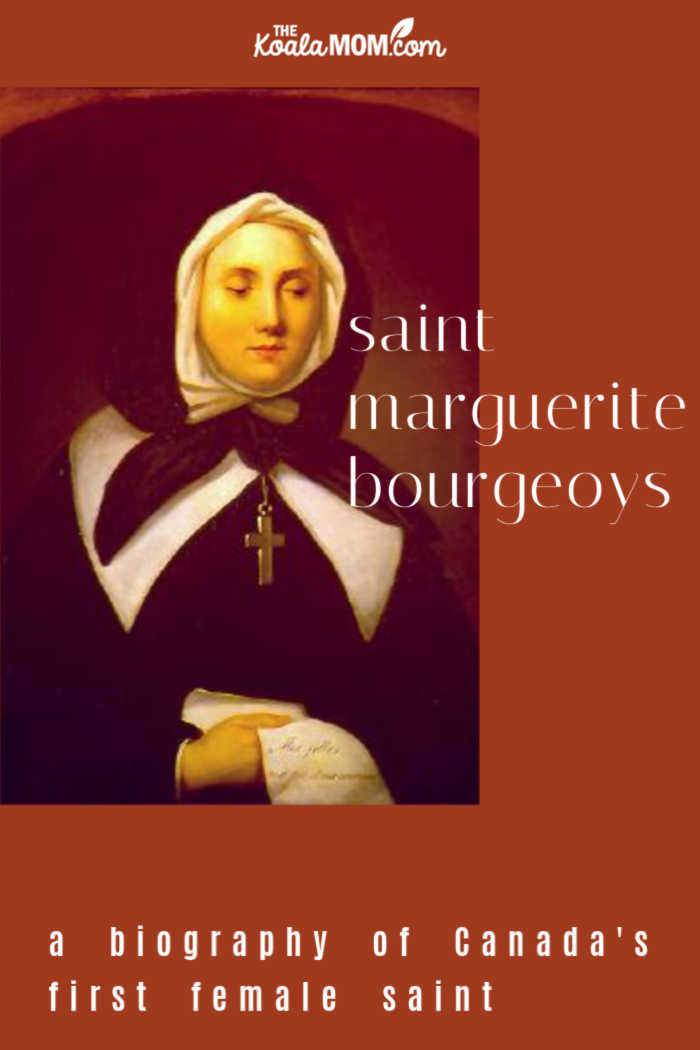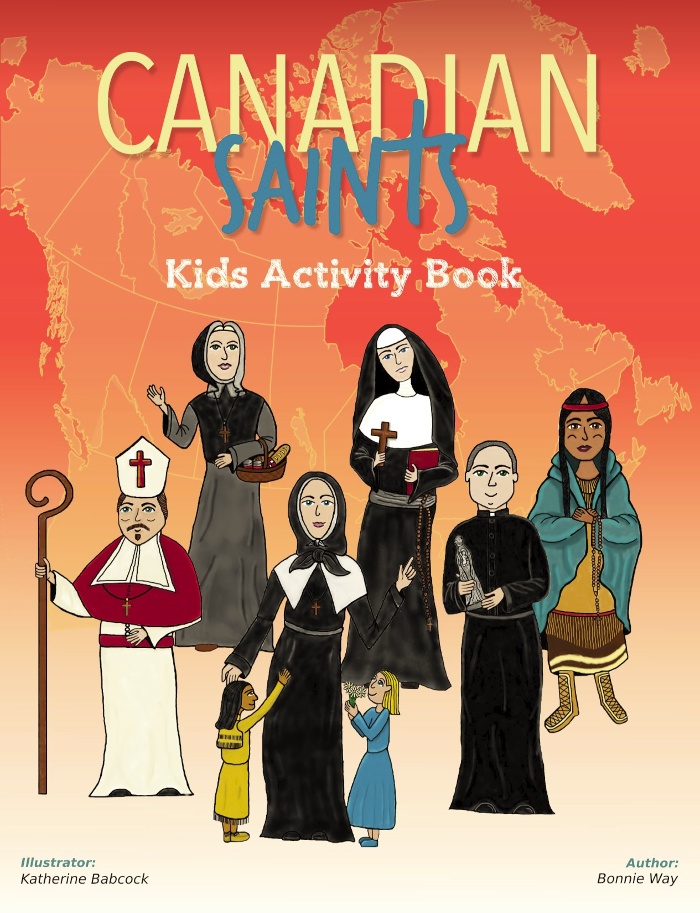I remember sitting in my best friend’s bedroom when I was ten or twelve, flipping through picture books of saint biographies. Each story was short and accompanied by a beautiful picture, and we’d take turns reading the stories and picking a saint whom we wished to be. Perhaps those early stories were an influence in my later conversion, for even now, I find myself attracted to the stories of the great men and women of the church, like Saint Marguerite Bourgeoys.

Marguerite Bourgeoys is a woman I admire in many ways. She was Canada’s first female saint, canonized in 1982 by Pope Saint John Paul II, and is considered the co-foundress of Montreal. Though she never married, she became the mother to the young women of Montreal, helping new immigrants settle into the city and teaching the young woman what they needed to know to raise their families.
This post contains affiliate links; as an Amazon associate, I earn from qualifying purchases.
Saint Marguerite Bourgeoys‘ Childhood
Marguerite was born on Good Friday in 1620 and baptized that same day. She was the sixth child of twelve, and her parents were part of France’s middle class. Marguerite was a typical girl, light-hearted and well-liked by her friends, until a strange encounter happened when she was twenty. During a process in honour of Our Lady of the Rosary, Marguerite looked up at an image of the Virgin and felt called to consecrate herself to God.
There was a local convent of cloistered nuns, who gave religious and pedagogical instruction to an external congregation of girls. Marguerite joined this external congregation and spent the next decade teaching poor local children. With six younger siblings, she was probably good with children and as well-liked by her pupils as her friends.
“Teaching is the work most suited to draw down the graces of God if it is done with purity of intention, without distinction between the poor and the rich, between relatives and friends and strangers, between the pretty and the ugly, the gentle and the grumblers, looking upon them all as drops of Our Lord’s blood.” ~ St. Marguerite, quoted in Sisterhood of Saints: Daily Guidance and Inspiration
Marguerite would have heard often about Canada and the newly established Montreal (then called Ville-Marie, in honour of the Virgin Mary), for its governor and founder Monsieur de Maisonneuve was her Mother Superior’s brother.
Learn more about St. Marguerite Bourgeoys with your children in Canadian Saints Kids Activity Book, now available!
Opportunity in New France
In 1652, Maisonneuve returned to France, looking for someone to teach the French and Aboriginal children in Montreal. Marguerite volunteered and felt Our Lady tell her, “Go, I will not forsake you.” She spent most of 1653 on her voyage to Montreal and arrived, along with a group of settlers, that fall. Unfortunately, there were no school-age children at the time because of high infant mortality. She became like a big sister to the settlers, acting as a social worker before the term was even used.
By 1658, Marguerite Bourgeoys was able to open her first school in a converted stable. Later that same year, she returned to France to seek other women to come teach with her, and returned with three girls. Along with her fellow teachers, Marguerite then began welcoming the young orphan women sent to France by King Louis XIV to start new families.
Young men had to apply to Marguerite and undergo serious examination from her before taking a wife. The community seemed to appreciate Marguerite’s role here and in teaching their children. In 1667, they resolved to ask the king to grant letters patent to Marguerite’s congregation (guaranteeing their work and existence).
1670 thus found Marguerite on her way back to France, alone and without money, to seek the king’s presence. Her congregation was noted to teach reading, writing and handiwork, and Colbert noted it “must be actively encouraged.” And so the following year, Marguerite received from the king the civil permissions to form her congregation of sisters. Three of her neices returned with her from this journey; two joined her congregation and one married a local settler.
Meeting the poor where they live—in ghettos and barrios and neighbourhoods unfamiliar to us—can be uncomfortable. Yet in our work with them, if we present ourselves with dignity and compassion, and offer the same, we can work together on a more level ground. ~ Melanie Rigney, Sisterhood of Saints: Daily Guidance and Inspiration
The next decade was a busy and successful one for Marguerite. She opened a boarding school, founded smaller schools in the local towns, and established a mission in the local Indian village. She had a heart for the less fortunate and the young Indian girls were particular favourites with her. Marguerite also ensured that her companions were trained in pedagogy and in a rule of life suited to their uncloistered community. She taught them to imitate the Virgin Mary’s earthly existence.
In 1680, Marguerite made her third and last voyage to France, seeking support for her community again. This was to be a difficult decade for her; a fire destroyed her mother house and caused the death of two of her companions. She had hoped to retire, but continued her work, supported by a new bishop.
More schools were founded, but the bishop pushed Marguerite’s community to join the local Ursulines. With the support of other priests and sisters, Marguerite continued to insist that her community had to be “secular nuns,” or nuns living among the people they served. In The Big Book of Women Saints, Sarah Gallick writes that Marguerite told her bishop, “The Blessed Virgin was never cloistered… she never excused herself from any journey on which there was good to be done or some work of charity to be performed.”
Saint Marguerite’s Death and Legacy
Marguerite Bourgeoys died in 1700, offering her life to God in exchange for that of another young nun who was close to death (and recovered). Her work in Quebec was continued by forty sisters of the Congregation de Notre-Dame; today, there are more than 2,600 sisters on mission in Canada, the US, and around the world. Her feast day is January 12 (the anniversary of her death) and she is the patron of orphans.
Marguerite was a woman ahead of her times, as noted by her biographer Helene Bernier. She insisted upon free education, even for girls, in a century when France was wondering whether daughters in the lower classes should receive education. She required her teachers to be trained and skilled. She recommended prudence and extreme moderation in the case of chastisement. And she reached out, not only to the settlers of New France, but also to the Indians, winning to herself the first two nuns to come from the Algonkin and Iroquois tribes.

Subscribe to my weekly email newsletter to download your FREE printable Canadian Saints & Blesseds Kids Activities Pack, which includes 8 Bingo cards with 30 Canadian saints’ and blesseds’ names, crossword puzzles and word searches, saint matching and sorting games, and a saint profile sheet. These activities are intended for kids about Grades 2+ (or children who can read and write). This Kids Activities Pack would be great for catechism classes, homeschool lessons, or a Canadian All Saints Day party.


No Responses Yet